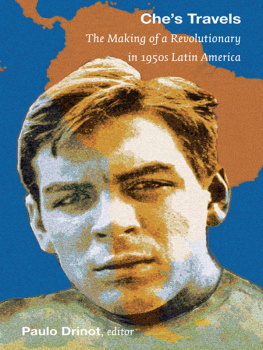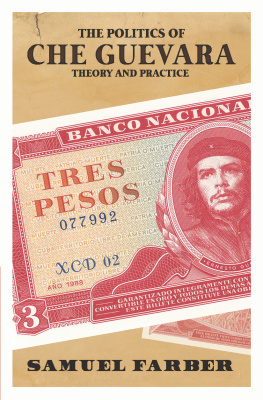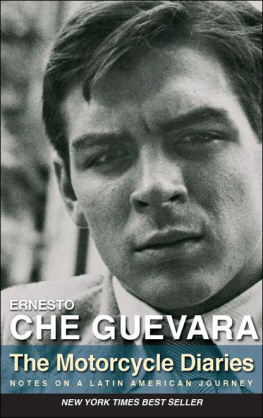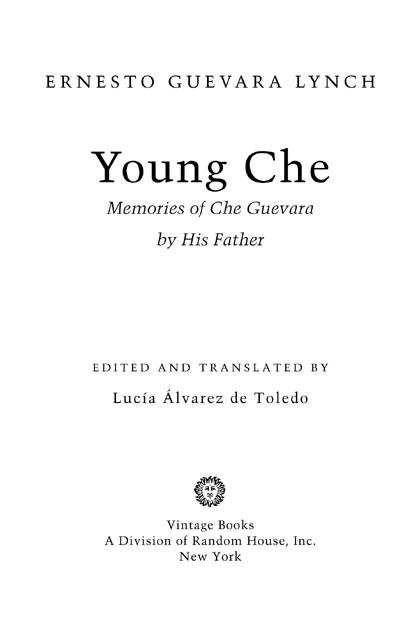ERNESTO GUEVARA LYNCH
Young Che
Ernesto Guevara Lynch, father of Che Guevara, was
born in Argentina in 1900 of Irish and Basque origin.
FIRST VINTAGE BOOKS EDITION, DECEMBER 2008
Translation, introduction, biographical notes, and chronology copyright 2007 by Lucalvarez de Toledo
All rights reserved. Published in the United States by Vintage Books, a division of Random House, Inc., New York. Originally published in Spanish in two separate volumes as Mi hijo el che by Editorial Planeta, Barcelona, in 1981, and Aqu va un soldado de Amrica by Editorial Sudamericana/Planeta, Buenos Aires, in 1987. Copyright 1981 and 1987 by The Estate of Ernesto Guevara Lynch. Letters of Che Guevara copyright 1947, 1953, 1954, 1955, 1956, 1957, 1958 by The Estate of Ernesto Che Guevara. This translation originally published in Great Britain by Vintage Random House, a member of the Random House Group Limited, London, in 2007.
Vintage and colophon are registered trademarks of Random House, Inc.
Grateful acknowledgment is made to Viking Penguin, a division of Penguin Group (USA) Inc., for permission to reprint two lines quoted from The Song of Despair from Twenty Love Poems and a Song of Despair by Pablo Neruda, translated by W. S. Merwin, copyright 1969 by W. S. Merwin.
Library of Congress Cataloging-in-Publication Data
Guevara Lynch, Ernesto.
[Mi hijo el Che. English]
Young Che: memories of Che Guevara by his father / Ernesto Guevara Lynch; edited and translated by Luca lvarez de Toledo.1st Vintage Books ed.
p. cm.
Originally published under the titles Mi hijo el Che and Aqu va un soldado de Amrica. Includes bibliographical references.
eISBN: 978-0-307-80645-1
1. Guevara, Ernesto, 19281967. 2. Guevara, Ernesto, 19281967
Correspondence. 3. GuerrillasLatin America
Correspondence. 4. GuerrillasLatin AmericaBiography.
I. lvarez de Toledo, Luca.
II. Guevara Lynch, Ernesto, 1900 Aqu va un soldado de Amrica. English. III. Title.
F2849.22.G85G8313 2008
980.035092dc22
[B]
2008032196
Pictures copyright The Personal Archive of Ernesto Guevara Lynch
Picture number 18 copyright Oficina de Asuntos Histricos de Cuba Map copyright Reginald Piggott
www.vintagebooks.com
v3.1
Contents
Acknowledgements
I wish to thank Aleida March de la Torre for permission to publish Che Guevaras letters, my editor Mandy Greenfield for her invaluable editorial advice and insight, and my literary agent Margaret Hanbury for her commitment and guidance.
I am also grateful to Charles Carlino, Alexandra Potts and Matthew Reisz for their continuous assistance and support throughout the project.
Luca lvarez de Toledo
Introduction
Ernesto Che Guevara has been dead forty years and yet there is a continuing fascination with the young and charismatic guerrilla who went to his death in a remote and desolate corner of the world with the cheerful elan he had displayed throughout his life. But how did a sickly boy from a comfortable background become one of the great revolutionary heroes of the twentieth century?
The Young Che offers us an intimate portrait of Guevara from his birth in 1928 up to the turning point of his life in 1956, when he joins Castro to train for the invasion of Cuba. It can be read as a record of a remarkable and lovable personality, as the journey (both real and psychological) of a revolutionary in the making and as a colourful tour of Latin America in the 1950s. All these things and more, it is now available in English for the first time.
The Young Che has been created from two separate books written by Ches father Ernesto Guevara Lynch: Mi hijo el Che (My Son Che) and Aqu va un soldado de Amrica (Here Goes a Soldier of the Americas). As such, it offers an intimate picture of Che en famille by one of the people who knew him best. Until these books were published in Spanish in 1981 and 1987 (the latter posthumously), very little was known about Ches early years. All subsequent biographies have drawn on them extensively for their chapters on his childhood and youth. This edition gives English readers access to the primary sources, with the essential background information set out in a Chronology, and with Biographical Notes giving brief descriptions of all the people mentioned.
We get to see the young Che through the loving eyes of his father, who often looked after him as a child during his frequent bouts of asthma and who, having been one of Ches political role models, became one of his most ardent followers. Yet much of the book consists of Ches own words, since Guevara senior quotes extensively from his diaries and from his letters to his parents, his close family and his best friend and fellow student, Tita Infante. There is simply no other detailed first-hand narrative of the trips Che embarked upon, of his reactions to what he saw, of the scrapes he got into in Bolivia, Peru, Ecuador, Panama, Costa Rica, Nicaragua, Guatemala and Mexico. His irony and self-mockery show him capable of great humour even in the face of adversity. All his dominant qualities the qualities that spurred him into political activism and helped him inspire such devotion stand out vividly here: his idealism, sharp observation and spontaneous empathy; his love of archaeology, his curiosity and constant desire for adventure.
The first half of The Young Che, originally published as My Son Che, offers a unique account of his Argentine childhood in a nonconformist bourgeois family, which was always committed to radical causes. Despite their class, the Guevaras were clean-scrubbed, unaffected people, never influenced by material fashions. Their homes in Alta Gracia, Crdoba and Buenos Aires were always open, friendly places, where no one ever knew exactly how many people were coming to dinner relatives, the childrens fellow students, visiting academics, professional colleagues or exiled Spanish Republican politicians and intellectuals. The younger generation grew up self-sufficient and free, but with a strong moral sense. Because of his upbringing as well as his chronic asthma, Ernestos education was unlike that of his peers and he matured quickly, becoming an iconoclast as well as a young man in a hurry. We discover the single-minded fury with which he played rugby; the impact of the books he read voraciously when his illness kept him at home; and the political events that rocked the world of his teens the Spanish Civil War and the effects of Nazism in Argentina.
This section of the book also contains Ches diary of his journey around northern Argentina in 1950, which Guevara Lynch discovered by accident in 1975 when the storage room in the basement of his flat in downtown Buenos Aires was flooded. Che covered around 4,700 kilometres on his bicycle, often going without food or sleep an endurance test that would be good training for his future career as a guerrilla. This first trip was followed by another, in 1952, when Che was a medical student and decided to cross Latin America on a motorbike with his close friend Alberto Granado, who was a few years older and already a doctor. Both men kept diaries of the journey, which have been published in English as Guevaras The Motorcycle Diaries and as Granados Travelling with Che Guevara (Pimlico, 2003). These formed the basis for Walter Salles film,






